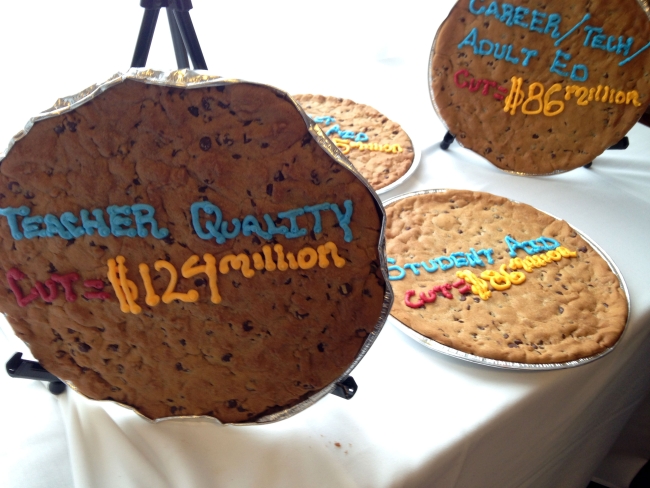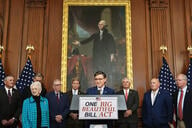You have /5 articles left.
Sign up for a free account or log in.

The Committee for Education Funding distributed cookies and cookie crumbs to Congressional offices Wednesday as part of a mock bake sale to raise funds for education programs harmed by sequestration.
Michael Stratford
The impending shutdown of the federal government is expected to affect higher education only modestly, at least in the short term, but the debate has already kicked off several months of unpredictable fiscal fights that threaten to further cut funding for some financial aid programs and scientific research.
The federal government will shut down on October 1 unless Congress agrees in the next five days to a stopgap spending measure to keep it open.
A lapse in funding would mean that most normal day-to-day operations of the federal government would come to a halt, though it’s not clear exactly which programs relating to higher education might continue.
The White House last week directed federal agencies, including the Education Department, to update their plans for operation during a government shutdown, but those documents have not yet been released.
“Agencies are still in the process of reviewing relevant legal requirements and updating their plans,” Emily Cain, an Office of Management and Budget spokeswoman, said in an e-mail Wednesday. “Determinations about specific programs are being actively reviewed as agencies undertake this process.”
Recent history, however, sheds some light on how agencies may proceed during a government shutdown. In anticipation of a shutdown in 2011 (which was ultimately averted at the last minute), the Education Department estimated that it would have to furlough up to 94 percent of its total staff and would call in a limited number of employees on a partial or rotating basis if the shutdown dragged on longer than a week.
Research funding may also be affected. The National Science Foundation prepared in 2011 to furlough all but 30 employees on its 2,000-person staff. Researchers with existing grants would have been allowed to continue work on their awards so long as they did not require any intervention from NSF staff. Similarly, the National Institutes of Health reported that existing extramural research grants would not be affected, though the agency said it would not provide any new awards.
The Education Department said in 2011 that the administration of federal student aid programs would largely be unaffected by a government shutdown, at least for the first week. The department said it would likely be able to continue disbursing Direct Loans, Pell Grants and other financial aid dollars on a short-term basis. However, the department warned at the time, a shutdown lasting longer than a week would begin to “severely curtail” funding to colleges and universities.
Dan Madzelan, a former Education Department official in the Office of Postsecondary Education, experienced several government shutdowns during his decades at the department.
“The process was to come to work on October 1, and commence an ‘orderly shutdown of the government’ for several hours,” he said. “That basically meant clearing the paper off your desk, making sure you put the plastic cover on your typewriter, and, as will be more relevant now, making sure your computer is off.”
Madzelan said the shutdowns he experienced, while disruptive and stressful for employees, generally did not lead to significant problems.
Still, he said, there were lingering effects from the shutdown in December 1995 that lasted for several weeks. The lack of enough people on the job, he said, probably contributed to a serious technological problem several weeks later with the processing of financial aid application forms, which caused significant delays for large numbers of students.
Justin Draeger, the president of National Association of Student Financial Aid Administrators, said that previous shutdowns had minimal effects on institutions in terms of administering financial aid to students.
“If we have a brief government shutdown, I’d say the concern is pretty minimal,” he said. “If we get into a prolonged government shutdown, the ability of schools and the department to work on complex student or borrower issues would be a problem."
Fiscal Fights Ahead
But more worrisome, said Draeger and other higher education advocates, are a series of fiscal fights that will play out on Capitol Hill over the next several months. Even if the government does not shut down, Congress is likely to pass only a stopgap spending bill that will last at most several months and leaves intact the sequester cuts to campus-based financial aid programs and scientific research.
Compounding the problem further are negotiations over raising the debt ceiling, which the Treasury Department says the government will hit on October 17. If the government were to run out of money to pay its obligation, higher education advocates worry that federal student aid and research funding would take a hit as the government chooses which bills to pay.
“Nobody comes out of any these debates and bills and says, ‘we did a great job’,” said Jonathan Fansmith, the associate director of government relations at the American Council on Education, lamenting the uncertainty surrounding short-term temporary funding compromises and stopgap measures. “There’s no good policy being made, it’s simply a sort of triaging of problems month to month, year to year.”
Advocates for education funding on Wednesday held a rally on Capitol Hill, urging Congress to reverse the sequester cuts they say have already been devastating to both higher education and K-12 schools. Holding a mock “bake sale” for education, the Committee for Education Funding distributed cookie crumbs to a handful of Congressional offices to show what would be left of education if the federal government kept cutting budgets.




